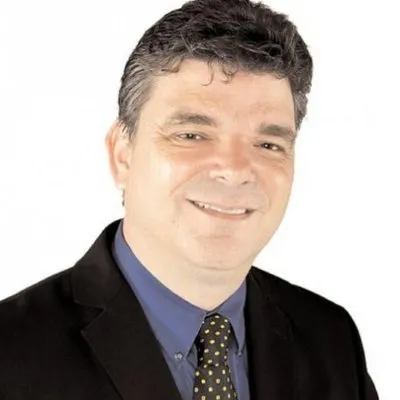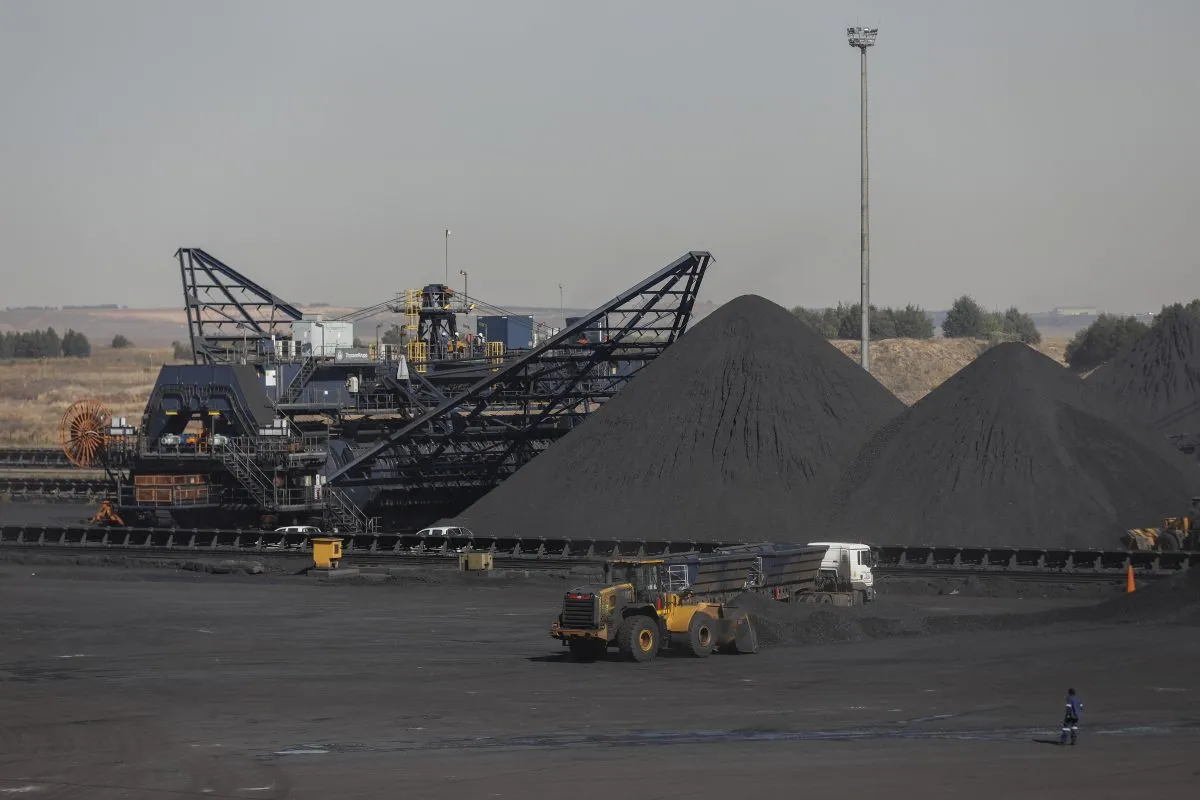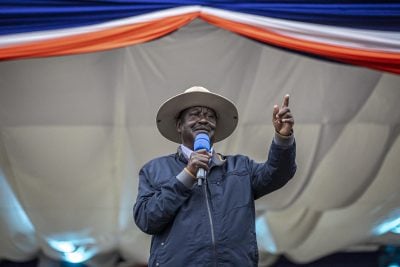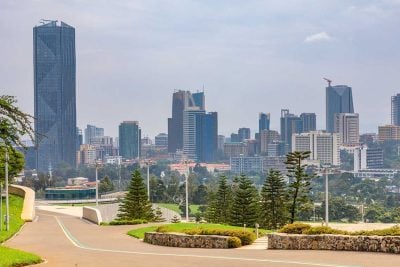As part of the push for net zero in Africa there is dwindling support from financial institutions and governments for coal projects. South Africa’s Integrated Resource Plan sets out a scheme to decommission 10,000 MW of coal-fired plants and replace it with gas and renewables. A multi-billion dollar just energy transition partnership (JETP) is in place, backed by wealthy western states, to help with the transition, even after US President Donald Trump pulled loans for the project.
Despite this, mining multi-millionaire Tim Tebeila believes dirty coal is still top of the South African energy heap. “Coal is here to stay for more than 100 years. This is a fact: yes, it will not die anytime soon. A lot of industry depends on coal. The steel industry here relies on coal. There is not any green energy that can feed a furnace,” says Tebeila.
This year Tebeila is putting his money where his mouth is. He has reopened his coal mining operation in the massive Waterberg coalfield in the northern Limpopo province of South Africa – a largely untapped resource with an estimated 30bn tonnes of coal, only some of which is controlled by Tebeila; enough to last the country for up to 50 years.
Feeding South Africa’s coal addiction
Tebeila mothballed his Waterberg coal-mining operation about three years ago, because of weak coal prices and problems with the railway lines both to the power stations and to the Richards Bay Coal Terminal, the export hub on the KwaZulu-Natal coast. He owns a coal washing plant in Mpumalanga and mines on eight properties, covering 11,000 hectares, with an estimated 5bn tonnes in reserves in the Waterberg.
But this year Tebeila’s 800 workers began mining 150,000 tonnes per-month from the Waterberg, as the railway problems ebbed and the opportunities flowed. The best of it is sold as coking coal to steel furnaces: in March a government-owned investor pumped $92m into ArcelorMittal South Africa to keep its steel operations alive in the country. About a third goes for export, priced in US dollars; the rest is
sent by rail to the many coal-fired power stations in Mpumalanga, which prop up the always-shaky national grid.
Tebeila supplies three coal-fired power stations: Kendal, with 4,116 MW in installed capacity; Majuba, with 4,110 MW; and Arnot, with 2100 MW. Between them they can light up 10m South African homes.
Decades ago, the electricity public utility Eskom talked of phasing out South Africa‘s ageing coal-fired plants, which shoulder the country’s electricity baseload demand. Today, coal still produces an estimated 85% of South Africa’s electricity, despite the planned shift towards renewables. Tebeila remains bullish on the black stuff. “Eskom’s got a great appetite. The rails are OK and there is a lot of demand there in the power stations of Mpumalanga,” he says.
Joining the ranks of SA’s mining millionaires
Sunlight bounces off a Maserati and Mercedes parked on the tiled piazza in front of the huge, polished, wooden front door flanked by sparkling fountains at Tebeila’s Johannesburg mansion.
It is furnished lavishly in the gold and lilac of France’s seventeenth-century Bourbon Sun King Louis XIV; a mini-Versailles in Africa. It also recalls the brash New York home of America’s billionaire president Donald Trump.
“All of this I bought from France, the same furniture shop as Donald Trump!” grins Tebeila. The luxury abode is the fruit of a life spent building an empire of coal, iron, platinum and gold. A photograph, in pride of place high on a wall, depicts Tebeila sitting next to the first democratically elected president of South Africa, Nelson Mandela. Tebeila’s Sekoko Resources, an unlisted black-owned mining firm, has taken his net worth from $28m a decade ago and is estimated to have grown considerably since.
Yet breaking into the mining world was far from easy. Early attempts to gain mining licenses were rebuffed.
In 2005 came the breakthrough. Tebeila secured a mining right that he felt could make his fortune. It was in Soutpansberg, near Messina on South Africa’s border with Zimbabwe, on Tebeila’s home turf of Limpopo province.
The permit area was spread over 8,000 hectares across 11 farms, promising 200m tonnes of coal. The only problem was that he couldn’t raise the $100,000 needed for initial exploration – a memory that irks him to this day.
“It is very funny – the funders want to finance someone who has money, not someone with ideas and a good business plan, someone with money already. So, I have learnt that in my entire life I have never borrowed money from any institutions. I financed my business by making money myself and generating income out of it,” he says.
Tebeila learned the hard way about the perils of raising capital. One crisp winter’s morning he went to speak to the people of his village, near Bela-Bela. It was a tough job to convince them to invest their life savings into a coal mine that didn’t exist yet.
The next morning, a blind woman shuffled into Tebeila’s office on the arm of one of her children. She proffered her life savings – about $1,000.
Tebeila was humbled. More money tumbled in from other villagers, allowing him to engage an Australian mineral consulting company to explore the area. All was well, or so it seemed. One morning, on instinct, he decided to check on the consultants, only to find an empty office. Without a word to Tebeila, the company had packed up and returned Down Under. It meant Tebeila would have to stand before the people he grew up with and tell them he had lost their hard-earned money.
Rescued data
He remembered the laboratory that the runaway consultants had used to process data in nearby Witbank. There, Tebeila managed to retrieve two flimsy pages of exploration data containing vital drilling information. From those two pages experts were able to reconstruct the report of the entire coal project.
Convinced of its enduring potential, Tebeila spent five frustrating months trying to sell the Soutpansberg coal project to various investors. Most people in the industry didn’t want to know – Brazilian mining giant Vale showed a flicker of interest, but Tebeila was running out of time and money.
One day he was driving along the highway from Limpopo when a phone call changed his life. It was from established mining player Coal of Africa, which offered to buy 74% of the assets for 70m rand (about $3.8m at today’s exchange rate) and pledged to invest more to take the project to a bankability feasibility study. “It was the biggest deal I ever got while I was driving!” recalls Tebeila.
It was the first of many mining deals that have subsequently spanned coal, iron, manganese, platinum, chrome, gold and uranium.
Learning in Limpopo
It is fitting that Tebeila’s initial fortune was made amid the mountains of Limpopo where he hustled his way out of poverty. If ever there was any doubt it was going to be a hard life, there was the long walk to school before sunrise from the tiny village where he grew up. It was 20 kilometres, barefoot, through the jagged, stony mountain paths. He had to rise at 4am.
“I was thrashed every day, for being late, for two years,” he recalls with a slight grimace, “The toughness of making me an entrepreneur is from my background…living in this kind of environment, I’ve learnt that hardship is the one that made me say that no one was born an entrepreneur.”
This painful start in life left the son of a priest with a desire to get on and a keen eye for a hustle. In the days of apartheid, poor black teenagers like Tebeila weren’t expected to amount to much amid hardship and exclusion. To be a village school teacher – a chance to be respectable and wear a tie – was about the best they could hope for. Back in the 1980s he spotted an opportunity on the 100km bus trip from Limpopo to his teaching job in Pretoria.
“As a teacher, the first three months into the job you didn’t get a salary, so to survive I sold bus tickets,” he says. “When people got on the bus, I was there to sell them a 20 rand ticket for 15 rand. When they alight, I would be there to collect my tickets to sell them again. I always knew I was going to make a good 30 rand in the morning before arriving at school,” he recalls with a chuckle. “I entered in the business of
selling those tickets to earn income of 800-rand-a-month. It was quite a lot of income, I can tell you.”
When he was a teenager, he spotted how taxi drivers could deliver boxes of apples far from Johannesburg. “I could buy this box of apples and if there were fifty apples for 50 rand, I could sell it for double the price to get 100 rand. It was time to stop playing soccer with the other kids,” he says.
All this paid his way through school and powered his ambitions to get ahead in a world that opened up for black entrepreneurs after the fall of apartheid.
Not just coal
Years later, having turned his initial success in the Soutpansberg into a diversified mining company – which also has interests in Botswana and Nigeria – Tebeila is still on the lookout for a golden chance. He is trying to revive his manganese mines in the Northern Cape. Like the coal mines, production was stalled by prices and a lack of rail transport. The manganese in the mines near Postmasburg in the Northern Cape is medium grade – abut 38% purity – and fit for the steelmakers of China, Africa’s biggest minerals customer.
Tebeila plans to ramp up production to 50,000 tonnes of manganese ore per month. He says new shafts will be sunk in the next few months, with a plan to take on 400 miners ready for production in the first quarter of 2026.
The biggest hurdle is infrastructure. “We don’t have enough rails; there is a bottleneck in that area. Everyone is still crying about rail. The rails are made for the majors and they were there long before us. We hope there will be a new window that will open up for the new players, but it doesn’t look like it is going to happen anytime soon.”
Tebeila has had to work out a massive trucking operation to get his manganese ore nearly 900 kilometres – a nine-hour trip one way – to export at the Coega port in Gqeberha (Port Elizabeth). He will engage 150 trucks to move 50,000 tonnes.
“One truck will need to make the trip every other day. A day there; a day back: one truck will carry 15 loads every month,” he says.
The poor teacher who sold bus tickets still has ambitions to fulfil. And in one of the few countries in the world where coal is still an attractive proposition, anything is possible.
Want to continue reading? Subscribe today.
You've read all your free articles for this month! Subscribe now to enjoy full access to our content.
Digital Monthly
£8.00 / month
Receive full unlimited access to our articles, opinions, podcasts and more.
Digital Yearly
£70.00 / year
Our best value offer - save £26 and gain access to all of our digital content for an entire year!

 Sign in with Google
Sign in with Google 



